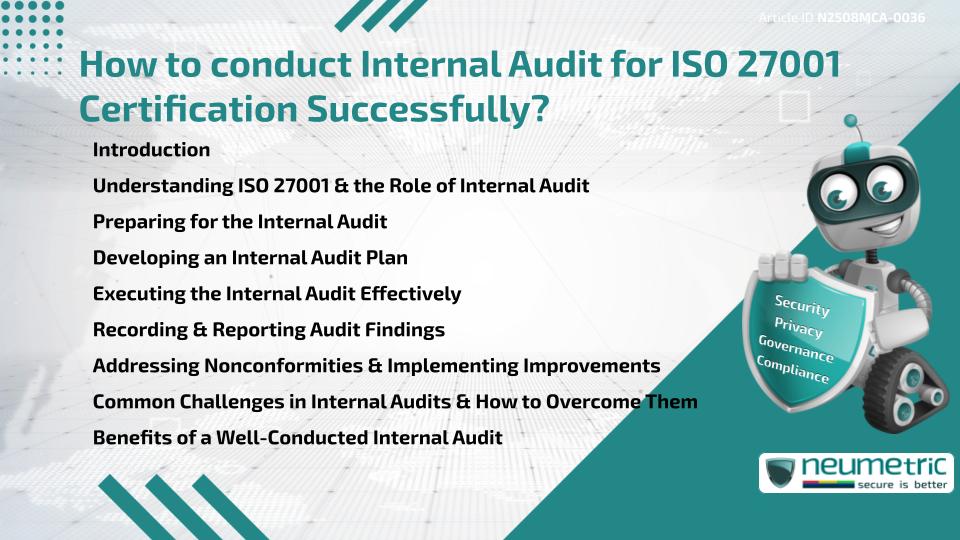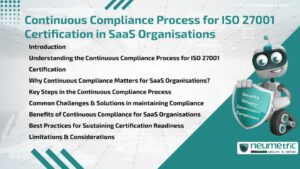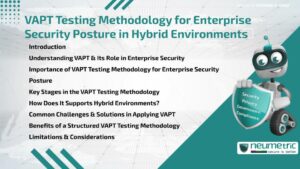Table of Contents
ToggleIntroduction
Knowing how to conduct Internal Audit for ISO 27001 Certification is essential for ensuring your Information Security Management System [ISMS] meets International Standards. An Internal Audit not only verifies compliance but also uncovers gaps, inefficiencies & Risks before an External Auditor does. This process involves understanding ISO 27001 requirements, preparing a structured Audit plan, executing the Audit systematically, reporting findings clearly & implementing Corrective Actions effectively. By following a well-organised approach, organisations can improve their security posture, boost confidence among Stakeholders & increase the chances of a successful Certification outcome.
Understanding ISO 27001 & the Role of Internal Audit
ISO 27001 is an International Standard for managing Information Security through an ISMS. An Internal Audit is a mandatory requirement that ensures the ISMS is operating as intended & meets the Standard’s clauses & controls. It acts as a “health check”, highlighting Vulnerabilities & confirming that Policies, processes & procedures are effective. Without this internal assurance, an organisation Risks nonconformities during the External Audit.
Preparing for the Internal Audit
Preparation is key. The process starts with defining the Audit’s scope, which should align with your ISMS boundaries & the organisation’s Business Objectives. Gathering relevant documents such as Policies, Risk Assessments, Control Implementation records & previous Audit Reports is critical. Selecting qualified & independent Auditors, ideally from within the organisation but outside the audited area, ensures objectivity.
Developing an Internal Audit Plan
An Internal Audit Plan sets the roadmap for the entire process. It should include the Audit Schedule, methods, resources & areas to be audited. Planning ensures coverage of all ISO 27001 clauses & Annex A controls. This document should be communicated to all relevant Stakeholders to avoid surprises & facilitate cooperation.
Executing the Internal Audit Effectively
During execution, Auditors should conduct interviews, observe processes & review records. Checklists aligned with ISO 27001 requirements can guide the process. The aim is to verify whether implemented controls address identified Risks & comply with documented procedures. Maintaining a professional & non-confrontational approach encourages transparency from Auditees.
Recording & Reporting Audit Findings
All observations must be documented in an Audit Report, which should include nonconformities, observations & positive findings. Clear evidence must back each finding. Reports should be concise yet comprehensive, allowing Management to understand the issues & their impact. The Report should be shared promptly so Corrective Actions can begin without delay.
Addressing Nonconformities & Implementing Improvements
Addressing nonconformities involves determining the Root Cause, implementing Corrective Actions & verifying their effectiveness. Improvements may also involve updating Policies, enhancing Controls or providing additional Training. Treating nonconformities as opportunities for improvement rather than failures fosters a proactive culture.
Common Challenges in Internal Audits & How to Overcome Them
Organisations often face challenges such as lack of Auditor independence, incomplete evidence, resistance from staff & inadequate time allocation. These can be overcome through proper Training, early communication, clear documentation & Management support.
Benefits of a Well-Conducted Internal Audit
A well-executed Internal Audit improves compliance, strengthens Security Controls, reduces the Likelihood of breaches & boosts confidence among Clients & Partners. It also prepares the organisation for the External Audit, increasing the chances of a smooth Certification Process.
Takeaways
- Define a clear scope & objectives for the Audit
- Ensure Auditor independence & competence
- Develop & follow a structured Audit Plan
- Maintain detailed & evidence-backed Reports
- Treat nonconformities as opportunities to improve
- Engage Stakeholders to promote transparency
FAQ
How often should an Internal Audit be conducted?
It is typically conducted annually but may occur more often depending on organisational needs.
What documents are needed for the Audit?
Policies, Procedures, Risk Assessments, control records, Training Logs & previous Audit Reports are essential.
How are nonconformities addressed?
By identifying Root Causes, implementing Corrective Actions & verifying their effectiveness.
Can the same person manage & Audit the ISMS?
No, Auditor independence is required to avoid conflicts of interest.
What happens if the Internal Audit finds many issues?
It highlights areas needing improvement before the External Audit, reducing Certification Risk.
Need help for Security, Privacy, Governance & VAPT?
Neumetric provides organisations the necessary help to achieve their Cybersecurity, Compliance, Governance, Privacy, Certifications & Pentesting needs.
Organisations & Businesses, specifically those which provide SaaS & AI Solutions in the Fintech, BFSI & other regulated sectors, usually need a Cybersecurity Partner for meeting & maintaining the ongoing Security & Privacy needs & requirements of their Enterprise Clients & Privacy conscious Customers.
SOC 2, ISO 27001, ISO 42001, NIST, HIPAA, HECVAT, EU GDPR are some of the Frameworks that are served by Fusion – a SaaS, multimodular, multitenant, centralised, automated, Cybersecurity & Compliance Management system.
Neumetric also provides Expert Services for technical security which covers VAPT for Web Applications, APIs, iOS & Android Mobile Apps, Security Testing for AWS & other Cloud Environments & Cloud Infrastructure & other similar scopes.
Reach out to us by Email or filling out the Contact Form…





